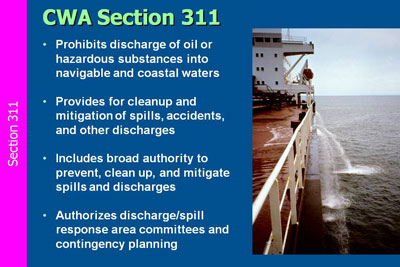Section 311 Program
Section 311 of the CWA addresses the discharge—including accidental spills—of oil and other hazardous substances into navigable and coastal waters. Under this section, ''oil'' means oil of any kind or in any form, including, but not limited to, petroleum, fuel oil, sludge, oil refuse, and oil mixed with wastes other than dredged spoil. “Discharge'' includes any spilling, leaking, pumping, pouring, emitting, emptying or dumping, but excludes permitted discharges (e.g., via an NPDES permit).
Section 311 prohibits discharging oil or hazardous substances into the navigable waters of the United States and adjoining shorelines, except where permitted under international protocol or under conditions that the President (i.e., through EPA regulations and authorities) determines not to be harmful. It also provides for the removal of an oil discharge and mitigation or prevention of the threat of a discharge into navigable and coastal waters, and other waters that could affect U.S. natural resources. Other provisions include broad authority for the President to make any arrangements for removal or prevention, direct removal actions, and remove or destroy a vessel releasing or that has the threat of releasing.
The section authorizes the establishment of Area Committees, which prepare Area Contingency Plans that detail methods and procedures for responding to a worst case discharge, including the division of responsibilities among various authorities in a response.
Web Resources:
EPA’s 401 Certification Handbook: A Water Quality Protection Tool for States and Tribes
![[logo] US EPA](https://www.epa.gov/epafiles/images/logo_epaseal.gif)
